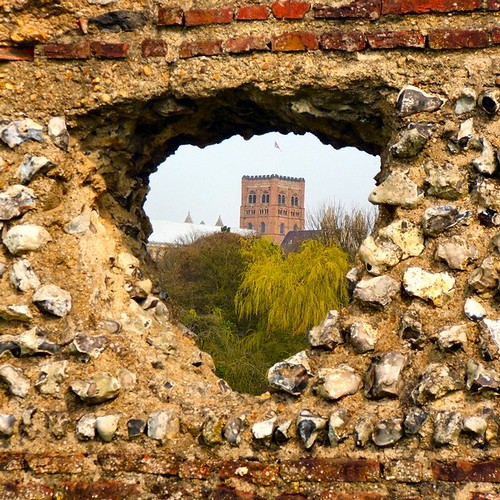 St Albans is about 40 minutes north of London, and a day return on the Thameslink route will set you back about £9. (There are two stations, but the Watford to St Albans Abbey line is much less convenient.)
St Albans is about 40 minutes north of London, and a day return on the Thameslink route will set you back about £9. (There are two stations, but the Watford to St Albans Abbey line is much less convenient.)There are a good number of walking tours available (the ghost walk, especially, is a good mix of local history and good story telling) but I'm going to write this in the style of one anyway. I grew up in St Albans, and writing this post is giving me flashbacks to a school project to write a tourist brochure for the city when I was 12... Anyway.
Leaving the station by the ticket-office side, and turning left and left again it's a short pleasant walk to the top end of the town centre, past the Victorian Clarence Park (home of St Albans City Football Club - a decent and cheap choice if you want to catch a 'local' football match in season - tickets are a mere £10 / £5 which is dirt cheap compared to the premiership clubs' prices.)
Following the road straight up, over the railway bridge and past the college, brings you out just by St Peter's church, originally founded in 948, along with the market. Bits of the 13th and 15th century church remain, but the current building almost all dates from an 1893 restoration. (personal aside : they have a ten bell tower, and are regional champion bell ringers, and I spent hours of my childhood sitting in a windowsill of the tower, as my dad rang there.)
The market runs on Wednesday and Saturday, with 170 stalls stretching the whole length of St Peter's Street, and it's worth timing your visit to coincide. Wednesday's market's got a slightly more 'arts and crafts' tilt to it, as not all the food stalls turn out mid-week, but either day is good. (The second Sunday of each month there's also a farmer's market outside the town hall, so if you're in town for a worship-visit to the Cathedral, check that out.)
Following the length of the market will take you down to the Medieval Clock Tower (80p/40p to climb on a Saturday) and the area of town used as a refuge by Henry VI during the War of the Roses (St Albans saw two major battles in the Civil War), and, across the road, a arrow passageway that will take you past the walled garden down to (mostly Norman) St Alban's Cathedral and Abbey Church.
St Alban was the earliest English Christian Martyr, according to the Venerable Bede (line vii). A Roman resident of Verumanium, Alban sheltered a priest, and was converted to Christianity by him. When soldiers came in search of the priest, Alba swapped cloaks with the man, allowing him to escape, and taking upon himself the punishment that would otherwise have been dealt to the priest - being made a human sacrifice to the city's Roman gods. The cathedral is supposed to be built on the site of his execution - originally as an important Abbey (the Magna Carta was drafted here) and then as a Cathedral.
When you've explored the Abbey, you can head down the grassy hill towards Verulanium Park for a drink in The Olde Fighting Cocks, which is the Guinness Book of Record's pick for the oldest pub in Britain (St Albans is also in the running for 'most pubs per head of population' and HQ of the Campaign for Real Ale) before heading past the lakes to go even further back in time, to the Roman occupation of the city.
There are several chunks of the Roman city walls visible in the park, and there square white building part way up the hill preserves and displays a (circa 100 AD) mosaic and hypocaust (free entry) while the impressive newly-extended Verulamium Museum (£3.30/£2) has good displays on everyday life in Roman Britain, and some of the finest Roman mosaics and wall plasters outside the Mediterranean (and if you hit a weekend when Legion XIIII are on patrol, even better). On, past the Verulamium Museum, there's the Roman Theatre (£2/1.50), the only British example of a theatre rather than an amphitheatre.
(There' also a City Museum, back towards the station, looking at the post-Roman history of the city, but I've always loved Verulamium, and am being shamelessly biassed.)
Coming back, you have the option of waffles in a 16th century water mill, and if you head back through the park, past the lakes, and picking up the Ver river, you will land at the foot of Holywell Hill, which will take you back into the town centre via several old coaching inns.
There's a bunch of things to do around and about the city, but I'm assuming that you're day tripping on foot / by train, so I won't include them here. (Hatfield House may show up as a separate trip.)
St Albans isn't short on pubs,and places to eat, but there's not a single club I'd recommend. The Horn Reborn, by the station, is the best venue for small bands, and won ‘Music Pub of the Year’ earlier this year.
No comments:
Post a Comment